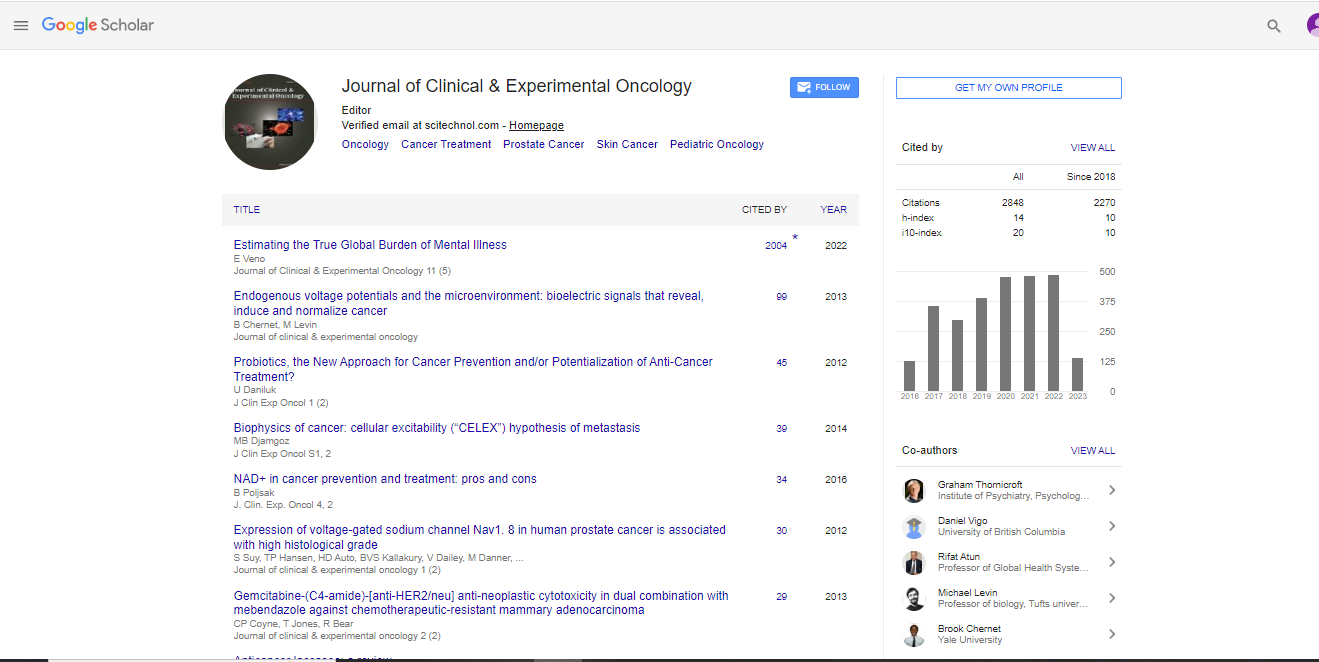Opinion Article, J Clin Exp Oncol Vol: 13 Issue: 2
Assessing Gastrointestinal Cancer: Clinical Approaches and Patient Care
Ruan Ping*
1Department of Systems Biology, Southern University of Science and Technology, Shenzhen, China
*Corresponding Author: Ruan Ping,
Department of Systems Biology, Southern
University of Science and Technology, Shenzhen, China
E-mail: ruanping@sust22.cn
Received date: 22 May, 2024, Manuscript No. JCEOG-24-143924;
Editor assigned date: 24 May, 2024, PreQC No. JCEOG-24-143924 (PQ);
Reviewed date: 07 June, 2024, QC No. JCEOG-24-143924;
Revised date: 14 June, 2024, Manuscript No. JCEOG-24-143924 (R);
Published date: 21 June, 2024, DOI: 10.4172/2324-9110.1000411
Citation: Ping R (2024) Assessing Gastrointestinal Cancer: Clinical Approaches and Patient Care. J Clin Exp Oncol 13:2.
Description
Gastrointestinal (GI) cancer encompasses a group of malignancies affecting the digestive system, including the esophagus, stomach, liver, pancreas, gallbladder, small intestine, colon, and rectum. These cancers represent some of the most common and deadly forms of cancer worldwide. Effective assessment and management of gastrointestinal cancers require a comprehensive approach, integrating advanced diagnostic techniques, personalized treatment strategies, and complete patient care. It explores the clinical approaches to diagnosing and treating GI cancers and emphasizes the importance of patientcentered care throughout the treatment journey. Gastrointestinal cancers are classified based on their location within the digestive tract. Each type has distinct risk factors, symptoms, and biological behaviors. Esophageal cancer often associated with smoking, heavy alcohol consumption, and Gastro-Esophageal Reflux Disease (GERD).
Gastric cancer linked to Helicobacter pylori infection, dietary factors, smoking, and genetic predispositions. Liver Cancer is commonly related to chronic hepatitis B or C infection, cirrhosis, and non-alcoholic fatty liver disease. Pancreatic cancer in which the Risk factors include smoking, chronic pancreatitis, diabetes, and certain genetic mutations. Colorectal cancer associated with a diet high in red and processed meats, sedentary lifestyle, obesity, smoking, and hereditary conditions like lynch syndrome and Familial Adenomatous Polyposis (FAP). Early detection of gastrointestinal cancers significantly improves treatment outcomes. A combination of screening programs, imaging techniques, endoscopic procedures, and biopsy methods is employed to diagnose these cancers accurately. Routine screening is essential, especially for colorectal cancer. Colonoscopy is the standard for colorectal cancer screening, allowing for the detection and removal of precancerous polyps.
Fecal Occult Blood Tests (FOBT) and Fecal Immunochemical Tests (FIT) are non-invasive screening options that can detect hidden blood in the stool, an early sign of colorectal cancer. Various imaging modalities are used to visualize tumors and assess their spread. These include Computed Tomography (CT) Scans provide detailed crosssectional images of the body, helping to stage cancer and plan treatment. Magnetic Resonance Imaging (MRI) provides highresolution images, particularly useful for liver and pancreatic cancers. Positron Emission Tomography (PET) Scans combined with CT (PETCT), these scans help identify metastases and evaluate treatment response. Endoscopy allows direct visualization and biopsy of the gastrointestinal tract. Upper endoscopy examines the esophagus, stomach, and duodenum for abnormalities. Endoscopic Ultrasound (EUS) combines endoscopy and ultrasound to evaluate the depth of tumor invasion and guide fine-needle aspiration for biopsy.
Colonoscopy visualizes the entire colon and rectum, enabling polyp removal and biopsy of suspicious lesions. Biopsy and histopathology definitive diagnosis requires tissue biopsy and histopathological examination. Molecular and genetic testing of biopsy samples can identify specific mutations and biomarkers, guiding targeted therapy and personalized treatment plans. The management of gastrointestinal cancers involves a multidisciplinary approach, tailored to the cancer type, stage, and patient’s overall health. Treatment modalities include surgery, chemotherapy, radiation therapy, targeted therapy, and immunotherapy. Surgical resection remains the primary curative option for localized gastrointestinal cancers. Esophagectomy removal of part or all of the esophagus for esophageal cancer. Gastrectomy involves partial or total removal of the stomach for gastric cancer.
Hepatectomy in which resection of liver tumors, often combined with liver transplantation in select cases. Pancreaticoduodenectomy (Whipple Procedure) it is a complex surgery for pancreatic cancer involving the removal of the pancreas head, duodenum, and parts of the bile duct and stomach. Chemotherapy involves systemic chemotherapy is used to kill cancer cells and shrink tumors, either as a primary treatment for advanced cancers or as an adjuvant therapy postsurgery. Combination regimens tailored to specific cancer types enhance efficacy. Radiation therapy in which high-energy radiation targets tumors, often used in conjunction with chemotherapy (chemoradiation) for synergistic effects. Advanced techniques like Intensity-Modulated Radiation Therapy (IMRT) and Stereotactic Body Radio-Therapy (SBRT) deliver precise doses, minimizing damage to surrounding tissues.
Conclusion
Gastrointestinal cancer remains a significant health challenge, but advancements in diagnostic techniques, personalized treatment strategies, and complete patient care have improved outcomes and quality of life for many patients. An integrated approach, integrating surgery, chemotherapy, radiation, targeted therapy, and immunotherapy, customized to individual patient needs, is essential for effective management. Moreover, comprehensive patient care addressing nutritional, psychological, and palliative needs ensures that patients receive the support necessary to manage their cancer journey. As studies continues to uncover new ideas and therapeutic options, the future holds potential for further improving the prognosis and care of gastrointestinal cancer patients.
 Spanish
Spanish  Chinese
Chinese  Russian
Russian  German
German  French
French  Japanese
Japanese  Portuguese
Portuguese  Hindi
Hindi 



